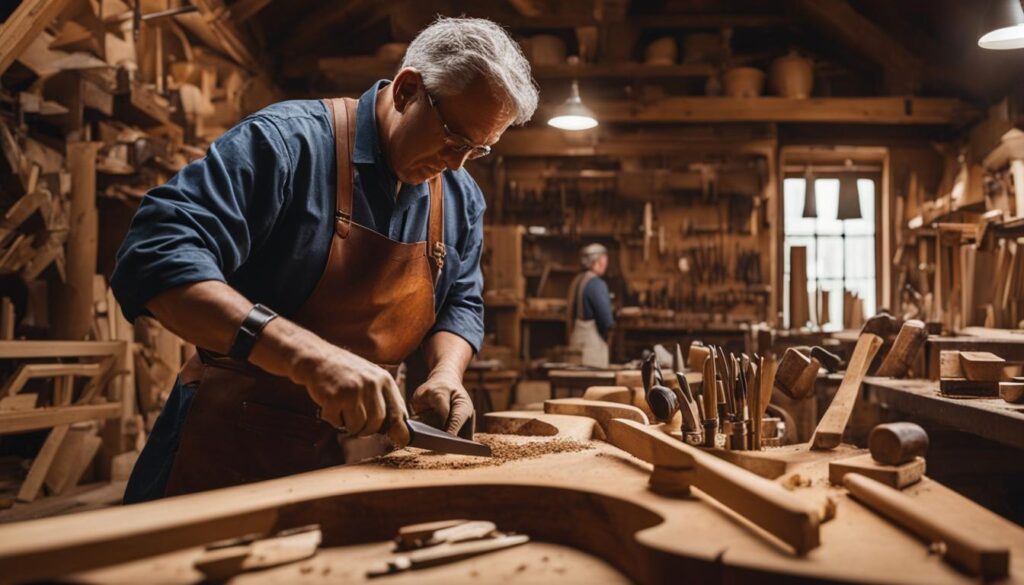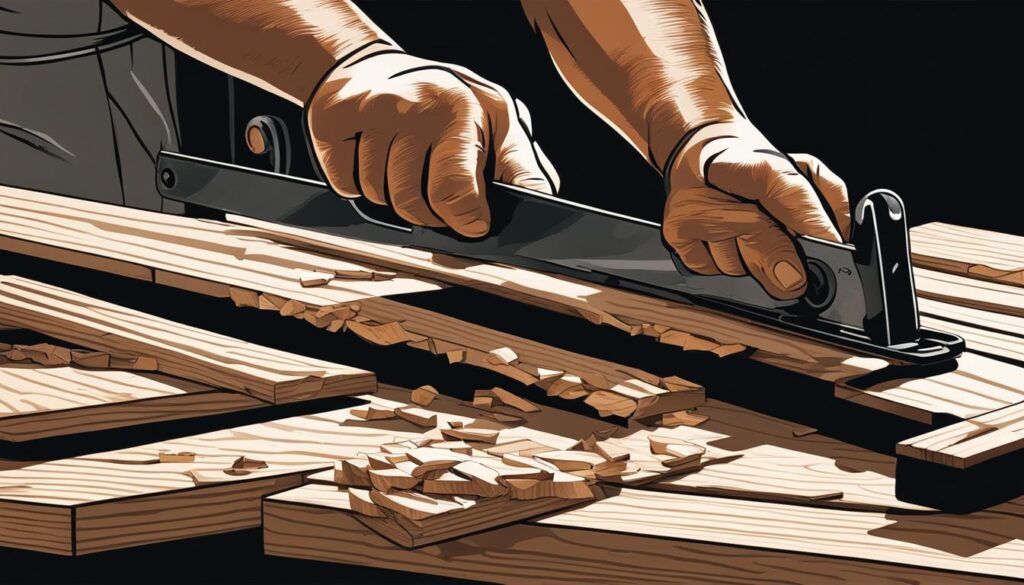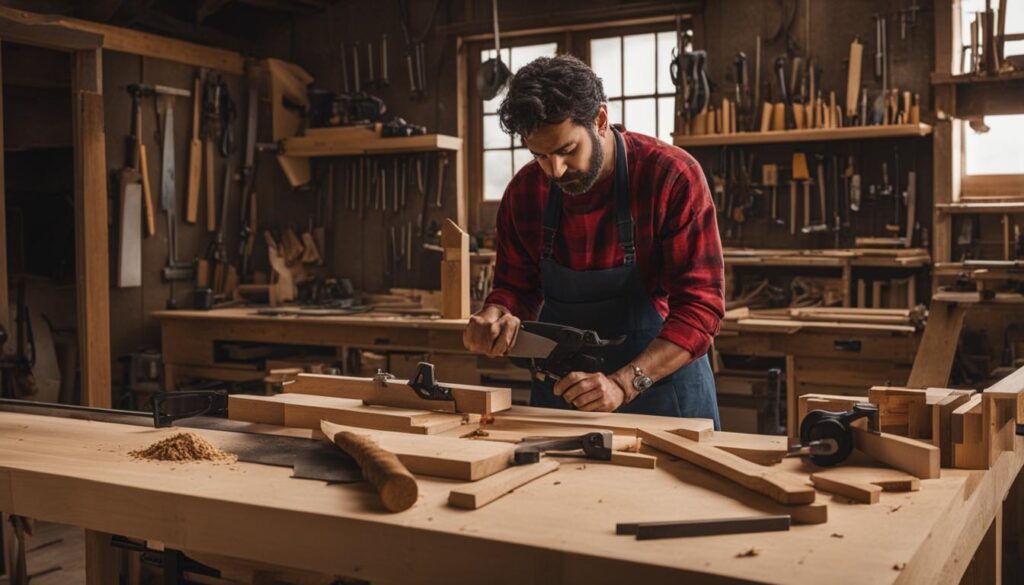We may earn money or products from the companies mentioned in this post.
Whether you are a professional woodworker or just starting, mastering furniture making techniques is essential to create exceptional pieces. Proper knowledge of woodworking, joinery, construction, and crafting techniques can enhance your skills and help you create elegant and long-lasting furniture.
In this comprehensive guide, we will explore all the essential Furniture Making Techniques that are needed for crafting high-quality furniture. We will begin with basic woodworking techniques, then move on to joinery techniques, furniture construction techniques, furniture crafting methods, and traditional and modern furniture making techniques.
Key Takeaways
- Furniture Making Techniques are crucial to create high-quality furniture with exceptional craftsmanship
- Woodworking, Joinery, Construction, and Crafting techniques are essential components of Furniture Making Techniques
- Mastering traditional techniques can add elegance to your furniture designs
- Incorporating modern techniques can help you explore new possibilities for your furniture creations
- Proper knowledge of woodworking tools and safety precautions is important for any woodworker
Understanding Woodworking Techniques
Before diving into specific furniture making techniques, it is essential to understand the basics of woodworking. Woodworking is the art of creating beautiful and functional objects out of wood. It requires skill, patience, and attention to detail.
Woodworking involves tools such as saws, chisels, planes, and drills. These tools must be handled with care and used with safety precautions in mind. Always wear protective gear such as goggles and gloves when working with these tools.
Fundamental Woodworking Skills
Every woodworker should have a few fundamental skills before attempting any furniture making techniques. These skills include:
- Measuring and marking accurately: Precise measurements are crucial for ensuring that pieces fit together correctly.
- Cutting straight lines: Start by practicing cutting straight lines with a saw. This skill is essential for many techniques.
- Sanding: Sanding smooths rough edges and surfaces, creating a beautiful finish for your furniture.
- Assembly: Knowing how to glue and clamp pieces together is crucial for successful furniture making.
By mastering these fundamental skills, you will be more confident and prepared to take on advanced woodworking techniques.
Essential Woodworking Tools
There are several essential tools that every woodworker must have in their toolkit. These include:
| Tool | Function |
|---|---|
| Saw | To cut wood into various shapes and sizes. |
| Chisel | To carve and shape wood. |
| Plane | To smooth rough surfaces and edges. |
| Drill | To make holes in the wood for screws and dowels. |
| Clamps | To hold wood pieces securely in place while glue dries. |
Having these tools in your toolkit will allow you to create a wide range of furniture pieces and execute various woodworking techniques with precision and ease.
“Woodworking is the art of creating something beautiful and functional out of a simple piece of wood. It requires patience, skill, and a love for craftsmanship.”
With a solid understanding of woodworking techniques and fundamental skills, you are ready to explore the world of furniture making. The next section will delve into various joinery techniques that are essential for creating durable and beautiful pieces of furniture.
Exploring Joinery Techniques
Joinery techniques are essential for creating durable and beautiful furniture pieces. Joining two pieces of wood without screws or nails requires skill and precision. Different types of joints are suitable for various furniture making projects.
Mortise and Tenon
The mortise and tenon joint is one of the most commonly used joinery techniques. It involves cutting a rectangular or square hole (mortise) into one piece of wood and a matching protrusion (tenon) on another piece that fits snugly into the mortise. Mortise and tenon joints are strong and durable and are often used to join legs to tabletops, rails to frames, and other structural connections.
Dovetail Joints
Dovetail joints are known for their strength and beauty. The joint involves cutting a series of interlocking shapes on two pieces of wood that fit tightly together. The resulting joint is self-locking and is often used in drawers and boxes, where durability and aesthetics are essential. Dovetail joints require precise handwork, making them a favorite among experienced woodworkers.
| Advantages of Dovetail Joints | Disadvantages of Dovetail Joints |
|---|---|
| Strong and durable | Require precision and patience to create |
| Self-locking | Difficult to repair if damaged |
Finger Joints
Finger joints are also known as box joints and are used for joining two pieces of wood at right angles. The joint consists of interlocking rectangular shapes that alternate between the two pieces of wood. Finger joints are easy to create with a table saw and are often used in cabinet making, drawers, and boxes.
- Easy to create using a table saw
- Provide ample gluing surface for a strong joint
- Can be decorative when used in visible areas
Choosing the right joint for your furniture project depends on several factors, such as the type of wood, the furniture’s function, and the desired aesthetics. Mastering joinery techniques is an essential skill for any woodworker who aims to create exceptional and long-lasting furniture pieces.
Furniture Construction Techniques: Creating Sturdy and Long-Lasting Pieces
One of the most critical aspects of furniture making is construction techniques. The way you construct a piece of furniture dictates its structural integrity, longevity, and resistance to wear and tear. In this section, we will explore several furniture construction techniques that will help you create sturdy and long-lasting pieces that stand the test of time.
Frame and Panel Construction
Frame and panel construction is a popular technique for constructing cabinet doors, table tops, and other large surfaces. This technique involves constructing a frame from solid wood and fitting panels into the frame. The panels are usually made from plywood, MDF, or solid wood, and they can be glued or left floating in the frame’s grooves to allow for expansion and contraction.
The frame and panel construction technique offers several advantages. The floating panel allows for seasonal wood movement, ensuring that the piece will not warp or crack with changes in humidity. Additionally, this construction method is relatively simple and can be used to create a wide range of furniture designs.
Drawer Construction
Drawers are an integral part of most furniture pieces, and constructing them correctly is essential to the overall quality of the piece. There are several different techniques for constructing drawers, including dovetail joints, box joints, and dowel joints.
Dovetail joints are the most popular method for constructing drawers. This technique involves interlocking pins and tails cut into the drawer sides and front. The pins and tails fit together tightly, creating a sturdy joint that resists racking and separating.
Box joints are another popular technique that involves cutting a series of interlocking fingers into the drawer sides and front. The fingers are then glued or pinned together, creating a joint that is strong and resistant to racking.
Case Construction
Case construction refers to the process of constructing the main body of the furniture piece, such as the sides, top, and bottom. There are several different techniques for constructing cases, including butt joints, rabbet joints, and dado joints.
Butt joints are the simplest case construction method and involve joining two pieces of wood by gluing or screwing them together at their ends. This technique is easy to execute, but the resulting joint is not very strong and can be prone to separation.
Rabbet joints involve cutting a groove, or rabbet, along the edge of one piece of wood and fitting the other piece into the groove. This technique allows for a tight fit and is relatively easy to execute.
Dado joints involve cutting a groove across the grain of one piece of wood and fitting the other piece into the groove. This technique is stronger than a rabbet joint but requires special tools and skills to execute correctly.
Furniture Crafting Methods: From Sketch to Reality
As a furniture maker, you want your creations to be visually appealing, functional, and built to last. Achieving these goals requires superior craftsmanship and a deep understanding of furniture crafting methods.
At the heart of any furniture piece is its design. Before starting any project, it’s important to have a clear idea of what you want to create. Sketching your design is an effective way to visualize your ideas and make adjustments before you begin construction.
Sketching Your Design
When sketching your design, consider the following:
- The dimensions of the piece
- The materials you will use
- The style or aesthetic you want to achieve
- The function of the piece
Once you have a rough sketch, you can refine it and create a more detailed plan. This will help you identify any potential challenges, such as structural support and assembly, and adjust your design accordingly.
Choosing Materials
The materials you choose will greatly impact the look and durability of your furniture piece. Hardwoods such as oak, cherry, and maple are popular choices due to their durability and beauty. Alternatively, softwoods such as pine and cedar can be used for a more rustic look.
When selecting materials, consider the following:
- The function of the piece
- The aesthetic you want to achieve
- The durability and strength of the material
- The cost and availability of the material
Measuring and Cutting
Precision is key when measuring and cutting your materials. Even a slight error can impact the structural integrity of your furniture piece. Always double-check your measurements and use a sharp saw or cutting tool.
Joinery and Assembly
Joinery is the process of connecting two or more pieces of wood to create a sturdy and durable joint. There are many joinery techniques to choose from, including butt joints, lap joints, and mortise and tenon joints.
When assembling your furniture piece, it’s important to follow the design plan and ensure each joint is secure. Use clamps to hold the pieces together as you work, and take your time to ensure everything is aligned correctly.
Finishing Touches
Finishing your furniture piece is the final step in the crafting process. This involves sanding, staining, and applying a protective finish such as polyurethane. The finishing touches will enhance the beauty of your piece and protect it from wear and tear.
“Furniture making is an art, and like any art, it requires passion, creativity, and attention to detail. By following these furniture crafting methods, you can turn your ideas into reality and create pieces that will be treasured for generations.”
Exploring Traditional Furniture Techniques
Woodworking has been around for centuries, and traditional furniture techniques have stood the test of time. These methods are still popular among furniture makers today because of their unmatched beauty and durability. Whether it’s hand-carved details or intricate marquetry, traditional furniture techniques add a touch of elegance to any furniture piece.
Hand Carving
Hand carving is a traditional technique used to add intricate details to furniture pieces. Skilled craftspeople use handheld chisels and gouges to shape and sculpt wood, creating unique designs and patterns. This technique allows for a high degree of precision and control, resulting in stunning details that cannot be replicated with modern tools.
“Hand carving is an art form. It requires not only skill but also patience and attention to detail. Each piece I create is unique and tells a story.” – John, Master Woodworker
Marquetry
Marquetry is a decorative technique that involves applying veneer pieces cut into intricate patterns onto the surface of furniture pieces. This technique requires precision and careful attention to detail to ensure that each piece fits perfectly. The end result is stunning furniture with intricate designs that are both visually stunning and durable.
| Benefits of Marquetry | Challenges of Marquetry |
|---|---|
|
|
Wood Finishing Techniques
Wood finishing techniques are used to enhance the natural beauty of wood and protect furniture pieces from wear and tear. Traditional wood finishing techniques include staining, oiling, and waxing. These techniques require skill and attention to detail to achieve a consistent finish that showcases the beauty of the woodgrain.
“A good wood finish is like the icing on a cake. It enhances the natural beauty of the wood and protects it from the elements. The key is to apply the finish carefully and evenly.” – Sarah, Furniture Maker
Traditional furniture-making techniques are still highly valued by furniture makers today. These methods add a touch of elegance and charm to furniture pieces that cannot be replicated with modern tools. Whether it’s hand-carved details, intricate marquetry, or stunning wood finishes, traditional furniture techniques can elevate any furniture piece to a work of art.
Embracing Modern Furniture Making
Modern furniture making is all about breaking the mold and exploring new possibilities. As technology advances, so do the tools and techniques available to furniture makers. Here are some advanced woodworking techniques to consider implementing in your practice.
CNC Machining
CNC machining is a computer-controlled process that can efficiently produce complex and precise cuts in wood. It enables furniture makers to create intricate designs with minimal waste and high accuracy. It is perfect for creating curved shapes, intricate patterns, and complex joinery.
| CNC Machining Benefits | CNC Machining Drawbacks |
|---|---|
|
|
Laser Cutting
Laser cutting is a versatile technology that can cut, engrave or etch wood with a high level of precision. It can be used to create intricate designs, custom inlays or decorative patterns. Laser cutting can also be used to cut and engrave templates for traditional hand cutting techniques.
| Laser Cutting Benefits | Laser Cutting Drawbacks |
|---|---|
|
|
3D Printing
3D printing is a relatively new technology that can create intricate and complex shapes in a variety of materials, including wood. It is particularly useful for creating prototypes or small-scale reproductions of furniture designs.
| 3D Printing Benefits | 3D Printing Drawbacks |
|---|---|
|
|
By embracing these modern furniture making techniques, you can expand your creative horizons and create furniture pieces that are visually stunning and technically precise. However, it is important to remember that these tools and techniques should complement, not replace, traditional craftsmanship and design principles. Striking a balance between the old and the new can lead to exceptional furniture pieces that showcase the best of both worlds.
Conclusion
Mastering the techniques of furniture making is a never-ending journey that demands skill, creativity, and an unwavering focus on quality. By incorporating the woodworking, joinery, construction, and crafting techniques discussed in this guide, you can elevate your furniture making skills to a new level and create exceptional pieces that stand the test of time.
The Importance of Tradition
As you explore these techniques, it is essential to remember the importance of tradition. Traditional techniques have been refined over generations and continue to inspire modern furniture makers today. Hand carving, marquetry, and wood finishing techniques add an element of classic elegance to furniture designs.
Embracing Innovation
At the same time, it is important to embrace innovation. Advanced woodworking techniques like CNC machining, laser cutting, and 3D printing open up new possibilities for furniture designs. Combining traditional techniques with modern tools can create unique and exciting furniture pieces.
Continuing Your Journey
Remember, mastering furniture making techniques is a continuous journey. Don’t be afraid to experiment with new techniques, materials, and designs. With time, patience, and a dedication to quality, you can create furniture masterpieces that will be appreciated for generations to come.
FAQ
What are the essential tools for woodworking?
The essential tools for woodworking include a tape measure, a chisel set, a mallet, a hand saw, a power drill, a router, a miter saw, and a sander.
What safety precautions should I take while woodworking?
It is crucial to wear safety goggles, ear protection, and a dust mask while woodworking. Additionally, ensure that your tools are in good working condition, use sharp blades, and maintain a clean and well-organized workspace.
What are some common joinery techniques used in furniture making?
Some common joinery techniques used in furniture making are mortise and tenon joints, dovetail joints, and finger joints.
How do I choose the appropriate joint for a furniture project?
The choice of joint depends on various factors such as the type of wood, the desired strength of the joint, and the overall design of the furniture piece. It is important to consider these factors and select a joint that will provide both structural stability and visual appeal.
What are some furniture construction techniques?
Furniture construction techniques include frame and panel construction, drawer construction, and case construction.
How can I bring my furniture designs to life?
To bring your furniture designs to life, start by conceptualizing and sketching your ideas. Then, choose appropriate materials, take precise measurements, and employ woodworking techniques to execute your design. Pay attention to details and constantly refine your craftsmanship.
What are some traditional furniture techniques?
Traditional furniture techniques include hand carving, marquetry, and wood finishing techniques such as staining, varnishing, and waxing.
How can modern tools and techniques enhance furniture making?
Modern tools and techniques such as CNC machining, laser cutting, and 3D printing can enhance furniture making by allowing for precise and complex designs, increased efficiency, and the incorporation of innovative materials.
Affiliate Disclosure: This post may contain affiliate links. If you purchase through our link, we may receive a small commission, but at no additional cost to you. For more information, please see our Disclosure statement.



